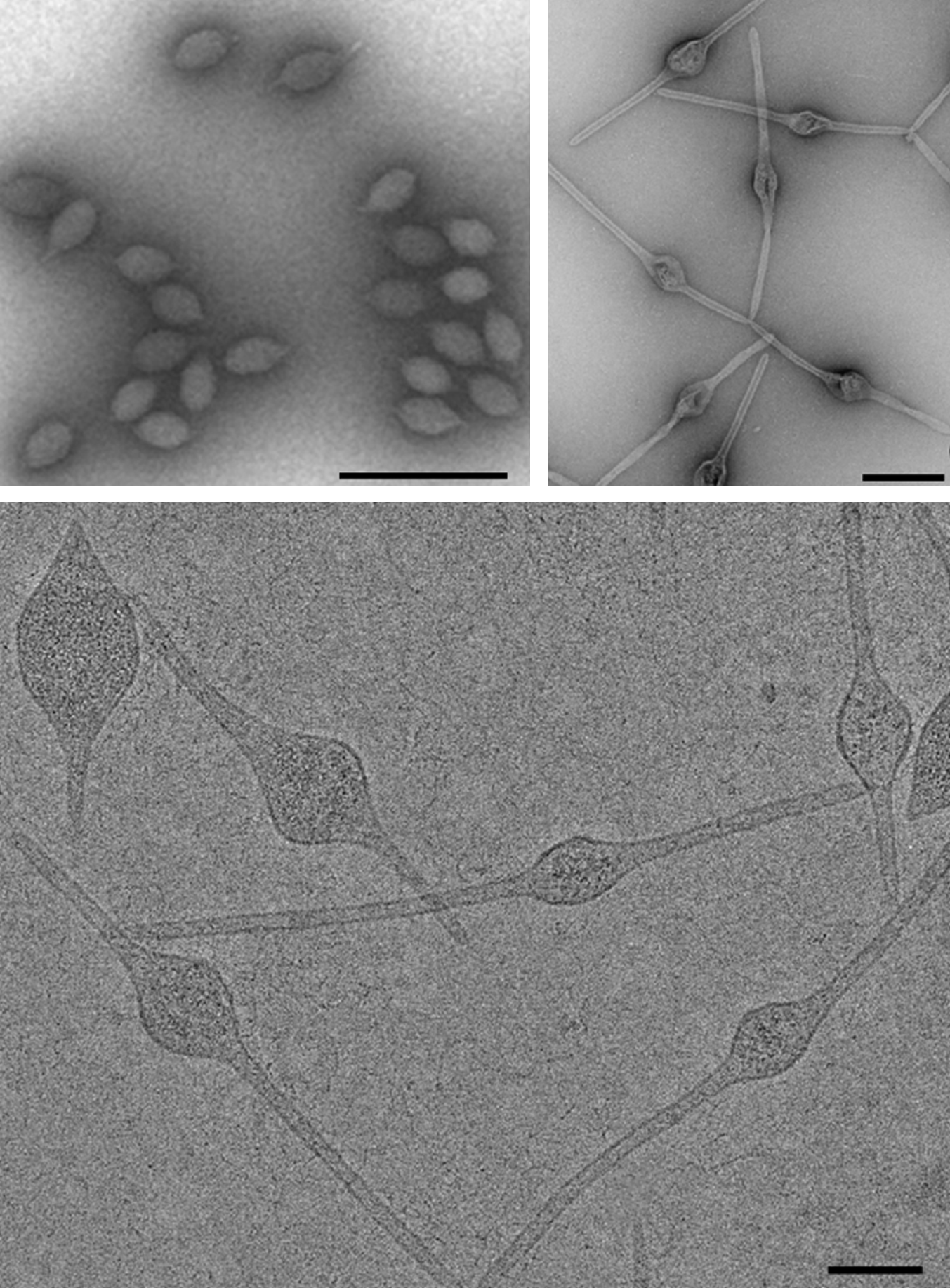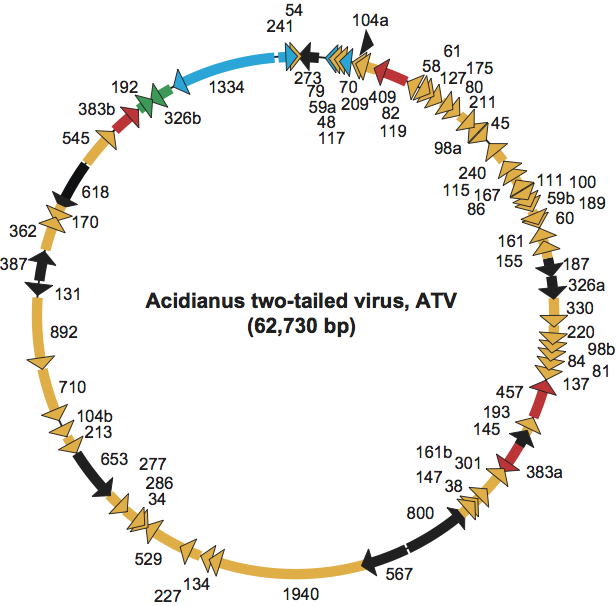Family: Bicaudaviridae
Chapter Version: ICTV Ninth Report; 2009 Taxonomy Release
Since only one genus is currently recognized, the family description corresponds to the genus description.
Genus Bicaudavirus
Type species Acidianus two-tailed virus
Virion properties
Morphology
Virions are released from host cells as lemon-shaped particles, about 120×80 nm, and thereafter develop long tails, one at each of two pointed ends (Figure 1). The tails are heterogeneous in length, reaching 400 nm. They have a tube-like structure with a wall about 6 nm thick. The tube ends in a narrow channel 2 nm in width and a terminal anchor-like structure formed by two furled filaments, each with a width of 4 nm.
Physicochemical and physical properties
Extracellular morphological development of the virion takes place specifically at temperatures above 75 °C, close to that of the natural habitat, and it does not require the presence of the host cells, an exogenous energy source and any co-factors. The average volume of the tailless virion is about 1.4 nm3, and that of the two-tailed virion 6.2 nm3. Conversely, the total surface areas for the two types of virions are similar, about 6×103 nm2. The mechanism of tail development is unknown.
Nucleic acid
Virions contain one molecule of circular dsDNA of 62,730 bp, with a GC content of 41.2%.
Proteins
Protein patterns of tailless and two-tailed virions are identical. The virions carry 11 major structural proteins (90, 80, 70, 60, 48, 45, 38, 22, 16, 15 and 12 kDa), five of which are modified at their N-termini. Several of the larger proteins are rich in coiled coil and/or low complexity sequence domains. The 80 kDa protein appears to be modified in two-tailed but not in tail-less virions.
Lipids
None reported.
Carbohydrates
None reported.
Genome organization and replication
The genome encodes 72 predicted proteins and carries four putative transposable elements, which constitute 8% of the genome (Figure 2). Forty-three genes are estimated to produce leader-less transcripts and 35 genes are organized in 12 putative operons. Several examples of gene duplication and duplication within the gene occur. Putative integrase, AAA-ATPase and an acyltransferase are encoded in the viral genome. No information is available on genome replication.
Antigenic properties
No information available.
Biological properties
The virus was isolated from a hot acidic spring (87–93 °C, pH 1.5–2.0) in Pozzuoli, Italy. The host range is limited to autochthonous species of hyperthermophilic archaea from the genus Acidianus The infection leads either to viral replication and subsequent cell lysis or conversion of infected cell into a lysogene. The lysogenic cycle involves integration of the viral genome into the host chromosome, probably facilitated by a virus-encoded integrase. The lysogeny can be interrupted by stress factors, e.g. UV-irradiation, decrease of temperature.
Species demarcation criteria in the genus
Not applicable.
List of species in the genus Bicaudavirus
| Acidianus two-tailed virus |
|
|
| Acidianus two-tailed virus | [AJ888457] | (ATV) |
Species names are in italic script; names of strains are in roman script. Sequence accession numbers [ ] and assigned abbreviations ( ) are also listed.
List of other related viruses which may be members of the genus Bicaudavirus but have not been approved as species
None reported.
List of unassigned species in the family Bicaudaviridae
None reported.
Phylogenetic relationships within the family
Not applicable.
Similarity with other taxa
Not known.
Derivation of name
Bicauda: from Latin bi, “two”, and cauda, “tail”.
Further reading
Häring, M., Vestergaard, G., Rachel, R., Chen, L., Garrett, R.A., Prangishvili, D., 2005. Independent virus development outside a host. Nature. 436, 1101–1102.
Prangishvili, D., Forterre, P., Garrett, R.A., 2006. Viruses of the Archaea: a unifying view. Nat. Rev. Microbiol. 4, 837–848.
Prangishvili, D., Garrett, R.A., Koonin, E.V., 2006. Evolutionary genomics of archaeal viruses: Unique viral genomes in the third domain of life. Virus Res. 117, 52–67.
Prangishvili, D., Vestergaard, G., Häring, M., Aramayo, R., Basta, T., Rachel, R., Garrett, R.A., 2006. Structural and genomic properties of the hyperthermophilic archaeal virus ATV with an extracellular stage of the reproductive cycle. J. Mol. Biol. 359, 1203–1216.
Contributed by
Prangishvili, D.
Figures
Figures
Figure 1 Electron micrographs of different forms of virions of an isolate of Acidianus two-tailed virus. (Top, left) Negative contrast electron micrograph of virions in tailless form. (Top, right) Negative contrast electron micrographs of virions in two-tailed form. (Bottom) Cryo-electron micrograph of two-tailed virions at different stages of extracellular tail development. The bars represent 100 nm (A,B) and 200 nm (C).
(From Prangishvili, D. et al. (2006). J. Mol. Biol., 359, 12031216.)

Figure 2 Genome organization of Acidianus two-tailed virus showing location, sizes and direction of the putative genes. Colour-coded ORFs correspond to: black, virion proteins; blue, homologous ORFs present in other archaeal hyperthermophilic viruses; green, homologous ORFs occurring in conjugative plasmids of the hyperthermophilic archaeon Sulfolobus; red, transposases.
(Modified from Prangishvili, D. et al. (2006). J. Mol. Biol., 359, 12031216.)

